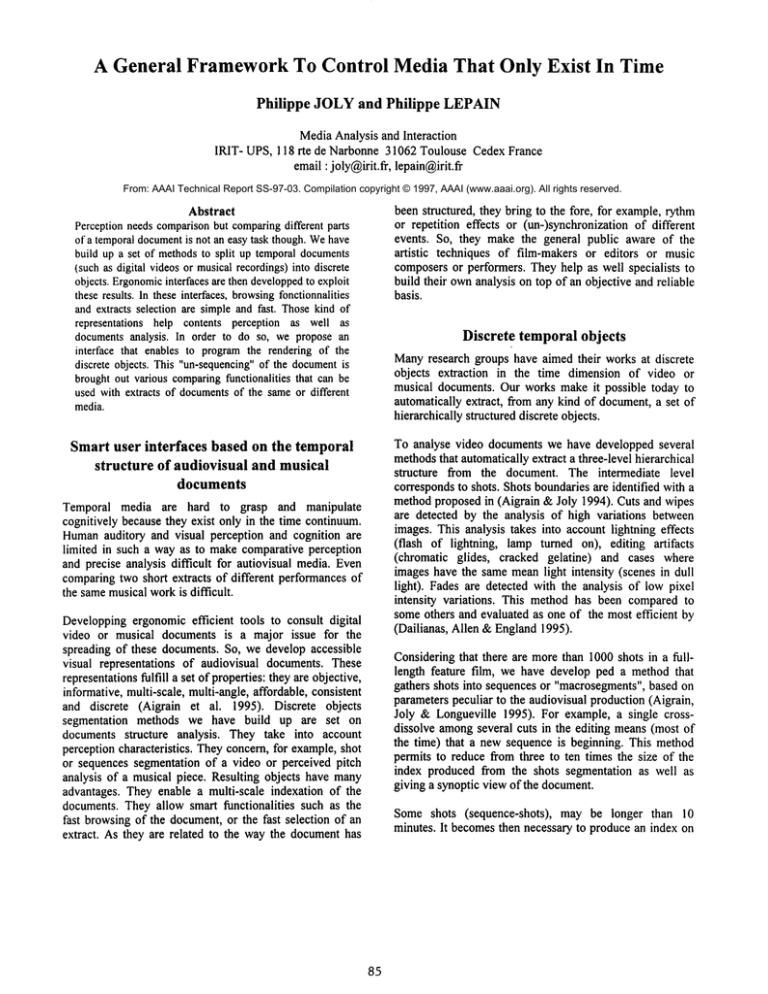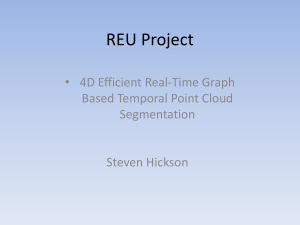A General Framework To Control Media That ...
advertisement

A General FrameworkTo Control Media That Only Exist In Time Philippe JOLY and Philippe LEPAIN MediaAnalysis and Interaction IRIT- UPS, 118 rte de Narbonne 31062 Toulouse Cedex France email: joly@irit.ff, lepain@irit.ff From: AAAI Technical Report SS-97-03. Compilation copyright © 1997, AAAI (www.aaai.org). All rights reserved. been structured, they bring to the fore, for example, rythm or repetition effects or (un-)synchronization of different events. So, they make the general public aware of the artistic techniques of film-makers or editors or music composersor performers. They help as well specialists to build their ownanalysis on top of an objective and reliable basis. Abstract Perceptionneedscomparisonbut comparingdifferent parts of a temporaldocument is not an easy task though.Wehave build up a set of methodsto split up temporaldocuments (suchas digital videosor musicalrecordings)into discrete objects. Ergonomic interfaces are then developped to exploit these results. In these interfaces, browsing fonctionnalities and extracts selection are simple and fast. Thosekind of representations help contents perception as well as documentsanalysis. In order to do so, we propose an interface that enables to programthe rendering of the discrete objects. This "un-sequencing"of the documentis broughtout various comparingfunctionalities that can be used with extracts of documentsof the sameor different media. Discrete temporal objects Manyresearch groups have aimed their works at discrete objects extraction in the time dimension of video or musical documents. Our works make it possible today to automatically extract, from any kind of document,a set of hierarchically structured discrete objects. Smart user interfaces based on the temporal structure of audiovisual and musical documents Temporal media are hard to grasp and manipulate cognitively because they exist only in the time continuum. Humanauditory and visual perception and cognition are limited in such a way as to make comparative perception and precise analysis difficult for autiovisual media. Even comparingtwo short extracts of different performancesof the samemusicalworkis difficult. Developpingergonomicefficient tools to consult digital video or musical documents is a major issue for the spreading of these documents. So, we develop accessible visual representations of audiovisual documents. These representationsfulfill a set of properties: they are objective, informative, multi-scale, multi-angle, affordable, consistent and discrete (Aigrain et al. 1995). Discrete objects segmentation methods we have build up are set on documents structure analysis. They take into account perception characteristics. Theyconcern, for example,shot or sequences segmentation of a video or perceived pitch analysis of a musical piece. Resulting objects have many advantages. They enable a multi-scale indexation of the documents. They allow smart functionalities such as the fast browsingof the document,or the fast selection of an extract. As they are related to the way the documenthas 85 To analyse video documents we have developped several methodsthat automatically extract a three-level hierarchical structure from the document. The intermediate level correspondsto shots. Shots boundariesare identified with a methodproposed in (Aigrain &Joly 1994). Cuts and wipes are detected by the analysis of high variations between images. This analysis takes into account lightning effects (flash of lightning, lamp turned on), editing artifacts (chromatic glides, cracked gelatine) and cases where images have the same meanlight intensity (scenes in dull light). Fades are detected with the analysis of low pixel intensity variations. This method has been compared to someothers and evaluated as one of the most efficient by (Dailianas, Allen &England 1995). Consideringthat there are more than 1000shots in a fulllength feature film, we have develop ped a method that gathers shots into sequences or "macrosegments",based on parameterspeculiar to the audiovisual production (Aigrain, Joly & Longueville 1995). For example, a single crossdissolve amongseveral cuts in the editing means (most of the time) that a new sequence is beginning. This method permits to reduce from three to ten times the size of the index produced from the shots segmentation as well as giving a synoptic view of the document. Some shots (sequence-shots), may be longer than minutes. It becomesthen necessary to produce an index on a sub-unit of a shot. To do so we have developped a method for the detection of camera movement.Then, we propose a micro-segmentation where each limit matches a change in the camera movement(Joly &Kim1996). Three years ago, our research group began to work on the segmentationof musicalobjects at different scale along the timeaxis. The first level of segmentation automatically extracts segments - that we call strokes - corresponding to quasistationary phases of the signal (Lepain &Obrecht 1995). vector of perceptive parameters is computed from each stroke (intensity, pitch, harmonicity, brightness, ...). method to extract perceived pitch from a polyphonic context (Lepain 1994) let us draw out the pitch and harmonicityof each stroke. The second level of segmentation bring out elements we call patterns. It relies on the analysis of the evolution in time of the parametersvector of each stroke. Rules similar to those established by F. Lerdhal and R. Jackendoff (Lerdhal & Jackendoff 1983) can then be applied for melodic patterns discrimination. The analysis of strokes intensity variation made it possible to segment dynamic patterns by adaptative thresholding. Weare now working on timbre classes discrimination. This will rely on intensity, harmonicity and brightness parameters. There are other research works that concern musical documents automatic segmentation. For example, (Cambouropoulos1996) is concerned with melodic contour extraction, (Todd & Brown 1995) deals with rhythmic groups multi-scale discrimination and (Mellinger 1991) about auditory flow analysis. To give an account of the documents structure is not sufficient for an analyst. The precise study of form and contents requires to have the opportunity to compare different extracts. It then makesnecessaryto be able to "unsequence" the document in order to compare distant objects, whether they are in the same documentor not. Considering these results, we propose new functionalities to organize and master time. to. They may be obtained with the fore-mentionned methods. Browsingoperators are infinite loops Q or finite loops Q (where n is the numberof iterations). Processing operators ~ are specific to the type of processed objects (scaling (video), pitch-shifting (music), filtering, slow/ fast playing, mixing(both)). The user is given the possibility to access a set of command for the real-time control of the nodes attributes values. He then can modifiy the progression through the tree as: - he plays/pauses the objects. It could also be possible to give him a command to stop the displaying of the current object and play the next one at a proportionnal starting position. This is a really efficient command to compare two performancesof the same workswith different tempi. - he acts on progression operators (immediate or differed exit of a loop). -he modifies treatment operators (filters thresholds, accelerationfactor.... ). The a priori tree specification and objects initialization make it possible to estimate the calculus cost of the (dis)playing so that it can be operatedin real-time. Applications Trees may be implemented through a simple language, or transparently proposed as functionalities of the user interface. For example, the traditionnal "play" function which is supposed to play a whole document is, in application of this formalism, associated to the tree 1, figure 1. Tree1 Tree2 finite loopoperator(1 iteration) temporalobjects Figure 1 : Examplesof simple trees Programming the way the objects are played The (dis)playing of time-linked media is modeled as progression through a treelike structure. Each node is a temporal object or an operator. Both have attributes accordingto their type. Whenreducing the duration attribute of consecutive temporal objects while conservingtheir beginningattribute, it becomespossible to produce a browsing functionnality that summarize the document as shown by the tree 2 in figure 1. - Temporalobjects O[._~ are of musical or video type. They have at least three attributes: their begin ning, their duration and the reference to the documentthey belong Weare developping nowan interface to give the user the choice between several browsing algorithms that can be interesting functiormalities to compareobjects whetherthey are in the same or in different documents. The user 86 initializes objects whichhave to be played and modifies the processing operators parameters. Let us consider for examplethe following display tree: To bring out this display specification and those functionnalities, it is necessary to consider a temporal document as made of discrete temporal objects. As we automate the segmentation on the basis of perception- or production-basedcriterion, we makeit possible to realize a very powerful framework for media consulting and studying. The proposeddiscrete objects are basic units for the traditionnal analysis that is considerably simplified by the methodsinvolved in our (dis)play strategy. infinite loopoperator z~x~) finite loopoperator(2 iterations) finite loopoperator(2 iterations) ~ time-stretchingoperator ~ temporalobject ioil r-~ ~ temporalobject References Figure 2 : Exampleof a tree to comparetwo temporal objects Aigrain, Ph.; Joly, Ph.; Lepain, Ph.; and Longueville, V. 1995. Representation-based user interfaces for the audiovisual library of year 2000. In Proceedingsof IS&T/ SPIE’95 Multimedia Computingand Networking, 2417:3545. San Jose, Calif. Using drag and drop functionnalities, the user select the temporal objects he wants to compare amongthose which are proposed on a document representation as shown in figure 3. He can play the tree as soon as the time stretching factor is given. He can act on the display using control commands as described in paragraph 3. Aigrain, Ph; and Joly, Ph. 1994. The automatic real-time analysis of film editing and transition effects and its applications. Computers&Graphics 18(1):93-103. discrete representation of a musical . :. ..... Dailianas, A; Allen, R; and England, P. 1995. Comparison of automatic video segmentation algorithms. In Proceedings of SPIE Photonics West. Philadelphia. document " drag anddropoperationto instanciate a temporalobject Aigrain, Ph; Joly, Ph; and Longueville, V. 1995. MediumKnowledge-Based Macro-Segmentation of Video into Sequences. In Proceedings of IJCAI Workshop on Intelligent Multimedia Information Retrieval - Ed. Mark Maybury- Montr6al. :® visual interface of a rendering algorithm Joly, Ph; and Kim, H.K. 1996. Efficient automatic analysis of camera work and microsegmentation of video using spatiotemporal images Signal processing : Image communication 8 (4) x 1.23 discrete tii On ~ ~ i ~ Lepain, Ph; and Andr6-Obrecht, R. 1995. Microsegmentation d’enregistrements musicaux. In Proceedings of Journ6es d’Informatique Musicale. Laforia. 81-90. (In French). r~epf~est~ed:~i Figure 3 : Exampleof a user interface proposedto comparetwo temporal objects It is noweasily possible to compare: - a theme and its repeat in a musical document, or the variation of the visual angle in a shot / reverse shot sequence in a video document (intra-document, monomedia comparison), -two performances of the same musical piece, different editing versions of a video (inter-document, mono-media comparison), a soundtrack as it has been commercializedand as it has been mixedin the audiovisual document(multimedia, interdocument comparison). 87 Lepain, Ph. 1994. Extraction de fr6quences fondamentales d’un document musical pour sa repr6sentation dans un systSmede consultation interactif. In Actes des Journ6es d’InformatiqueMusicale. Labri. 83-96. (In French). Lerdhal, F; and Jackendoff, R. 1983. A generative Theory of Tonal Music. MITPress. Cambouropoulos, E. 1996. A Formal Theory for the Discovery of Local Boundaries in a Melodic Surface. In Proceedings of Journ6es d’Informatique Musicale, Les cahiers du GREYC, n°4, p. 170-180, Caen, 1996. Todd, N.P.McA; and Brown, G. 1995.Visualization of Rhythm,Time and Metre. Artificial Intelligence Review. KluwerAcademicPublishers, Netherlands. 00:1-21. Mellinger, D.K. 1991. Event Formation and Separation in Musical Sound. Ph.D. diss., Dept. of ComputerScience, Stanford Univ. 88



